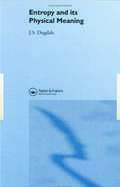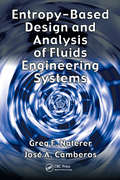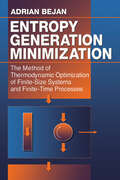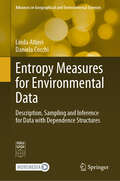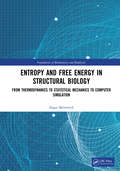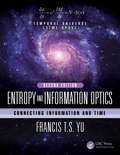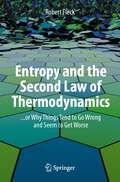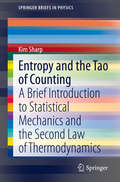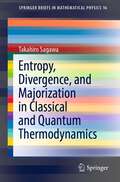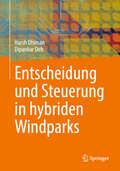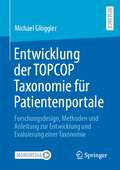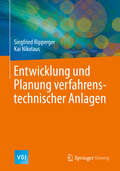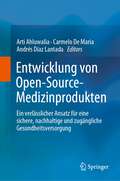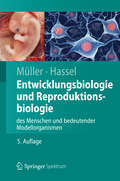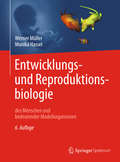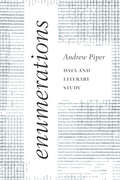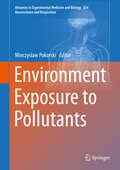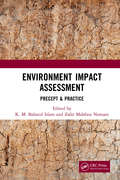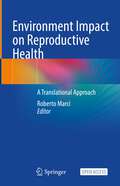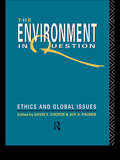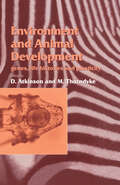- Table View
- List View
Entropy And Its Physical Meaning
by J. S. DugdaleThis text gives students a clear and easily understood introduction to entropy - a central concept in thermodynamics, but one which is often regarded as the most difficult to grasp. Professor Dugdale first presents a classical and historical view of entropy, looking in detail at the scientists who developed the concept, and at how they arrived at their ideas. This is followed by a statistical treatment which provides a more physical portrait of entropy, relating it to disorder and showing how physical and chemical systems tend to states of order at low temperatures. Dugdale includes here a brief account of some of the more intriguing manifestations of order in properties such as superconductivity and superfluidity.Entropy and Its Physical Meaning also includes a number of exercises which can be used for both self- learning and class work. It is intended to provide a complete understanding of the concept of entropy, making it valuable reading for undergraduates in physics, physical sciences and engineering, and for students studying thermodynamics within other science courses such as meteorology, biology and medicine.
Entropy Based Design and Analysis of Fluids Engineering Systems
by Greg F. Naterer Jose A. CamberosEntropy-based design (EBD) is an emerging new methodology that incorporates the Second Law into computational fluid dynamics (CFD) and measurement techniques. The book provides an overview of the design tool and its applications in various areas like microfluidics, multiphase flows, turbulence, compressible flows and others. It develops computational and experimental methods to track regions of highest entropy production. Containing extensive end-of-chapter references, the text also provides comprehensive coverage (related to entropy and the Second Law) of laser-based methods, numerical methods in CFD, entropy formulations and the Second Law in a range of thermofluid applications.
Entropy Generation Minimization: The Method of Thermodynamic Optimization of Finite-Size Systems and Finite-Time Processes (Mechanical and Aerospace Engineering Series)
by Adrian BejanThis book presents the diverse and rapidly expanding field of Entropy Generation Minimization (EGM), the method of thermodynamic optimization of real devices. The underlying principles of the EGM method - also referred to as "thermodynamic optimization," "thermodynamic design," and "finite time thermodynamics" - are thoroughly discussed, and the me
Entropy Measures for Environmental Data: Description, Sampling and Inference for Data with Dependence Structures (Advances in Geographical and Environmental Sciences)
by Daniela Cocchi Linda AltieriThis book shows how to successfully adapt entropy measures to the complexity of environmental data. It also provides a unified framework that covers all main entropy and spatial entropy measures in the literature, with suggestions for their potential use in the analysis of environmental data such as biodiversity, land use and other phenomena occurring over space or time, or both. First, recent literature reviews about including spatial information in traditional entropy measures are presented, highlighting the advantages and disadvantages of past approaches and the difference in interpretation of their proposals. A consistent notation applicable to all approaches is introduced, and the authors’ own proposal is presented. Second, the use of entropy in spatial sampling is focused on, and a method with an outstanding performance when data show a negative or complex spatial correlation is proposed. The last part of the book covers estimating entropy and proposes a model-based approach that differs from all existing estimators, working with data presenting any departure from independence: presence of covariates, temporal or spatial correlation, or both. The theoretical parts are supported by environmental examples covering point data about biodiversity and lattice data about land use. Moreover, a practical section is provided for all parts of the book; in particular, the R package SpatEntropy covers not only the authors’ novel proposals, but also all the main entropy and spatial entropy indices available in the literature. R codes are supplemented to reproduce all the examples. This book is a valuable resource for students and researchers in applied sciences where the use of entropy measures is of interest and where data present dependence on space, time or covariates, such as geography, ecology, biology and landscape analysis.
Entropy and Free Energy in Structural Biology: From Thermodynamics to Statistical Mechanics to Computer Simulation (Foundations of Biochemistry and Biophysics)
by Hagai MeirovitchNuclear Structure Physics connects to some of our fundamental questions about the creation of the universe and its basic constituents. At the same time, precise knowledge on the subject has led to the development of many important tools for humankind such as proton therapy and radioactive dating, among others. This book has chapters on some of the crucial and trending research topics in nuclear structure, including the nuclei lying on the extremes of spin, isospin and mass. A better theoretical understanding of these topics is important beyond the confines of the nuclear structure community. Additionally, the book will showcase the applicability and success of the different nuclear effective interaction parameters near the drip line, where hints for level reordering have already been seen, and where one can test the isospin-dependence of the interaction. The book offers comprehensive coverage of the most essential topics, including: • Nuclear Structure of Nuclei at or Near Drip-Lines • Synthesis challenges and properties of Superheavy nuclei • Nuclear Structure and Nuclear models - Ab-initio calculations, cluster models, Shell-model/DSM, RMF, Skyrme • Shell Closure, Magicity and other novel features of nuclei at extremes • Structure of Toroidal, Bubble Nuclei, halo and other exotic nuclei These topics are not only very interesting from a theoretical nuclear physics perspective but are also quite complimentary for ongoing nuclear physics experimental programs worldwide. The book chapters, written by experienced and well-known researchers/experts, will be helpful for master students, graduate students and researchers and serve as a standard and up-to-date research reference book on the topics covered.
Entropy and Information Optics: Connecting Information and Time, Second Edition (Optical Science and Engineering)
by Francis YuThis book shows there is a profound connection between information and entropy. Without this connection, information would be more difficult to apply to science. This book covers the connection and the application to modern optics and radar imaging. It shows that there exists a profound relationship between Einstein’s relativity theory and Schröinger’s quantum mechanics, by means of the uncertainty principle. In due of the uncertainty relation, this book shows that every bit of information takes time and energy to transfer, to create and to observe. The new edition contains 3 new chapters on radar imaging with optics, science in the myth of information, and time and the enigma of space.
Entropy and the Second Law of Thermodynamics: ... or Why Things Tend to Go Wrong and Seem to Get Worse
by Robert FleckThis book is a brief and accessible popular science text intended for a broad audience and of particular interest also to science students and specialists. Using a minimum of mathematics, a number of qualitative and quantitative examples, and clear illustrations, the author explains the science of thermodynamics in its full historical context, focusing on the concepts of energy and its availability and transformation in thermodynamic processes. His ultimate aim is to gain a deep understanding of the second law—the increase of entropy—and its rather disheartening message of a universe descending inexorably into chaos and disorder. It also examines the connection between the second law and why things go wrong in our daily lives. Readers will enhance their science literacy and feel more at home on the science side of author C. P. Snow's celebrated two-culture, science-humanities divide, and hopefully will feel more at home in the universe knowing that the disorder we deal with in our daily lives is not anyone's fault but Nature's.
Entropy and the Tao of Counting: A Brief Introduction to Statistical Mechanics and the Second Law of Thermodynamics (SpringerBriefs in Physics)
by Kim SharpThis book provides a complete and accurate atomic level statistical mechanical explanation of entropy and the second law of thermodynamics. It assumes only a basic knowledge of mechanics and requires no knowledge of calculus. The treatment uses primarily geometric arguments and college level algebra. Quantitative examples are given at each stage to buttress physical understanding. This text is of benefit to undergraduate and graduate students, as well as educators and researchers in the physical sciences (whether or not they have taken a thermodynamics course) who want to understand or teach the atomic/molecular origins of entropy and the second law. It is particularly aimed at those who, due to insufficient mathematical background or because of their area of study, are not going to take a traditional statistical mechanics course.
Entropy, Divergence, and Majorization in Classical and Quantum Thermodynamics (SpringerBriefs in Mathematical Physics #16)
by Takahiro SagawaRich information-theoretic structure in out-of-equilibrium thermodynamics exists in both the classical and quantum regimes, leading to the fruitful interplay among statistical physics, quantum information theory, and mathematical theories such as matrix analysis and asymptotic probability theory. The main purpose of this book is to clarify how information theory works behind thermodynamics and to shed modern light on it.The book focuses on both purely information-theoretic concepts and their physical implications. From the mathematical point of view, rigorous proofs of fundamental properties of entropies, divergences, and majorization are presented in a self-contained manner. From the physics perspective, modern formulations of thermodynamics are discussed, with a focus on stochastic thermodynamics and resource theory of thermodynamics. In particular, resource theory is a recently developed field as a branch of quantum information theory to quantify “useful resources” and has an intrinsic connection to various fundamental ideas of mathematics and information theory. This book serves as a concise introduction to important ingredients of the information-theoretic formulation of thermodynamics.
Entscheidung und Steuerung in hybriden Windparks
by Dipankar Deb Harsh DhimanDieses Buch fokussiert auf zwei zentrale Aspekte im Betrieb von Windparks: Entscheidungen und Steuerung. Im ersten Teil werden Entscheidungsprozesse erläutert, bei denen der Betrieb von Hybrid-Windparks von der Auswahl optimaler Alternativen zur Einspeisung von Windenergie ins Netz abhängt. Präzise Windvorhersagen sind entscheidend, um Fehler auszugleichen und mittels eines Batteriespeichersystems Reservekapazitäten ins Netz einzuspeisen. MCDM-Methoden und ein unscharfer Ansatz werden verwendet, um die besten Optionen zu bewerten. Fallstudien aus US-amerikanischen Windparks bieten numerische Lösungen. Im zweiten Teil liegt der Fokus auf der Steuerung, insbesondere der Yaw-Winkel-Steuerung zur Leistungsoptimierung der Turbinen. Eine Transferfunktions-basierte Methode zur Steuerung des Wirbelzentrums wird vorgestellt, begleitet von lidar-basierten Simulationen und adaptiven Steuerungsstrategien für verschiedene Windparklayouts. Die Auswirkungen des Yaw-Winkels auf die Betriebskosten des Batteriespeichersystems werden analysiert, unterstützt durch Fallstudien aus den USA und Dänemark.
Entscheidungen in die weite Zukunft: Ungewissheiten bei der Entsorgung hochradioaktiver Abfälle (Energiepolitik und Klimaschutz. Energy Policy and Climate Protection)
by Dirk Scheer Anne Eckhardt Frank Becker Volker Mintzlaff Roman SeidlIn diesem Open-Access-Buch werden Wege aufgezeigt, mit verschiedenen Formen von Ungewissheiten und der Dynamik von Ungewissheiten bezüglich der Entsorgung radioaktiver Abfälle umzugehen. Die sichere Entsorgung radioaktiver Abfälle erfordert es, über Zeiträume von bis zu einer Million Jahre hinaus zu planen. Ein solches Vorhaben ist von erheblichen Ungewissheiten begleitet, die sich zudem auf dem Entsorgungsweg verändern. Dem Sammelband liegen inter- und transdisziplinäre Forschungsergebnisse zugrunde. Die Autor:innen sprechen in allgemein verständlicher Sprache eine breite Leserschaft an, die sich für die Entsorgung radioaktiver Abfälle oder grundlegender für den Umgang mit Vorhaben, die sehr langfristig angelegt sind, interessiert.
Entwicklung der TOPCOP Taxonomie für Patientenportale: Forschungsdesign, Methoden und Anleitung zur Entwicklung und Evaluierung einer Taxonomie
by Michael GlögglerTaxonomien sind Modelle, um unübersichtliche Domänen zu analysieren, Komplexität zu reduzieren sowie Unterschiede und Ähnlichkeiten von Objekten zu erkennen. Ferner helfen sie, Wissen zu ordnen und so Wissen zu vergrößern. Da täglich neues Wissen entsteht, ist eine nutzungsorientierte Entwicklung von Taxonomien für die Wissenschaft und die Praxis von fundamentaler Bedeutung. Taxonomien sind unerlässlich für die Erforschung, Beschreibung und Strukturierung von Domänen. Trotz ihrer besonderen Bedeutung gibt es für viele Wissenschaften nur wenige Handlungsanleitungen zur Entwicklung von Taxonomien.In diesem Buch werden die Forschungsergebnisse der Dissertation mit dem Titel „Entwicklung einer Taxonomie für Patientenportale für Health Information Manager“ präsentiert. Aufgrund der detaillierten Darstellung der Entwicklungsschritte und der eingesetzten Methoden kann diese Dissertationsforschung als Anleitung zur Entwicklung von Taxonomien dienen. Dabei ist die Evaluierung für die Nützlichkeit einer Taxonomie maßgeblich. Mit dem „TED Taxonomy-Evaluation-Delphi Approach“ entwickelte der Autor eine neue Methode zur Evaluierung von Taxonomien, welche hier ausführlich beschrieben wird.
Entwicklung und Planung verfahrenstechnischer Anlagen (VDI-Buch)
by Siegfried Ripperger Kai NikolausDieses Fachbuch vermittelt wesentliche Grundlagen für die Entwicklung und Planung verfahrenstechnischer Anlagen, bei der technische, betriebliche, wirtschaftliche und rechtliche Forderungen beachtet werden müssen. Nach einer Einführung in die Anlagentechnik und das Projektmanagement werden wirtschaftliche Aspekte betrachtet, da die notwendigen finanziellen Mittel für eine Anlage in der Regel durch den zu erwartenden wirtschaftlichen Nutzeffekt gerechtfertigt werden. Verfahrenstechnische Anlagen sind oft einzigartig. Um dennoch eine zügige Projektabwicklung zu gewährleisten und um Kosten zu senken kommt der Modularisierung eine immer größere Bedeutung zu. Daher ist diesem Trend ein eigenes Kapitel gewidmet. Nach einer kurzen Einführung in das technische Recht werden zu beachtende rechtliche Aspekte behandelt. Weitere Kapitel beschreiben die Rolle der Normung, die große Palette der verwendeten Werkstoffe sowie bekannte Regeln zur Dimensionierung und Gestaltung von Bauelementen der Apparate.
Entwicklung und Validierung einer Prüfsystematik zur Charakterisierung von additiv gefertigten Thermoplast-Leichtbaustrukturen (Werkstofftechnische Berichte │ Reports of Materials Science and Engineering)
by Patrick StriemannDieses Buch befasst sich mit der Charakterisierung von additiv gefertigten Thermoplast-Leichtbaustrukturen. Die prozessbedingten Eigenheiten der additiven Fertigung beeinflussen die Prüfstrategien und die Charakterisierungsergebnisse. Daher werden einzelne Prüfstrategien zur Beurteilung der Qualität und der Leistungsfähigkeit auf das Verarbeitungsverfahren angepasst. Die qualitative Beurteilung erfolgte oberflächen- und volumenbasiert. Durch die Kombination beider Methoden konnten Ansammlungen von Porenvolumen den Fertigungseffekten zugeordnet werden. Die Bewertung des Verformungsverhaltens erfolgte in einem breiten Dehnratenbereich (statisch, quasistatisch und dynamisch), das Ermüdungsverhalten unter zyklischer Belastung wurde bis 108 Lastwechsel charakterisiert. Für die Untersuchungen im VHCF-Bereich wurde ein Hochfrequenz-Prüfsystem verwendet und die Temperaturentwicklung überwacht. Die adaptierten und neuentwickelten Prüfstrategien lassen sich in einer Prüfsystematik zusammenfassen, die die fertigungsbedingten Einflüsse berücksichtigen und einen sicheren Betrieb von langzeitbeanspruchten Thermoplast-Leichtbaustrukturen gewährleisten.
Entwicklung von Open-Source-Medizinprodukten: Ein verlässlicher Ansatz für eine sichere, nachhaltige und zugängliche Gesundheitsversorgung
by Andrés Díaz Lantada Arti Ahluwalia Carmelo De MariaDieses Buch befasst sich mit den Herausforderungen und Möglichkeiten von Open-Source- und kollaborativen Designansätzen und -strategien im biomedizinischen Bereich. Es bietet eine umfassende Reihe von bewährten Verfahren und Methoden, damit diese sicheren, innovativen und zertifizierbaren biomedizinischen Geräte die Patienten erreichen und erfolgreiche Lösungen für Probleme im Gesundheitswesen bieten. Die Kapitel sind so gegliedert, dass sie den gesamten Lebenszyklus von Open-Source-Medizintechnologien verfolgen. Die bereitgestellten Informationen sind äußerst praxisorientiert, da sie sich auf reale Studienfälle stützen, bei denen sich die Zusammenarbeit zwischen medizinischen Fachkräften, Ingenieuren und Technikern, Patienten und Patientenverbänden, politischen Entscheidungsträgern, Regulierungsbehörden und Bürgern als vorteilhaft erwiesen hat. Das Buch wird auch durch eine Online-Infrastruktur, UBORA, unterstützt, über die Open-Source-Medizinprodukte gemeinsam entwickelt und geteilt werden können, um die Medizintechnik zu demokratisieren und eine zugängliche biomedizintechnische Ausbildung zu fördern.
Entwicklungsbiologie und Reproduktionsbiologie des Menschen und bedeutender Modellorganismen
by Werner A. Müller Monika HasselDie faszinierende Entwicklung von Ei und Spermium zum komplexen Organismus ist das Thema des Lehrbuchs. Die Autoren liefern einen Überblick über die Entwicklung wichtiger Modellorganismen und die Embryonalentwicklung des Menschen. Dabei berücksichtigen sie aktuelle Forschungsfragen wie u. a. Klonen, transgene Tiere und Gentherapie. In der 5. Auflage sind alle Abbildungen 4-farbig, die Themen "Entwicklung des Menschen" und "Evolution von Entwicklungsprozessen" werden ausführlicher dargestellt. Mit umfangreichem Glossar und Literaturverzeichnis.
Entwicklungsbiologie und Reproduktionsbiologie des Menschen und bedeutender Modellorganismen (Springer-lehrbuch)
by Werner A. Müller Monika HasselDie faszinierende Entwicklung von Ei und Spermium zum komplexen Organismus ist das Thema des Lehrbuchs. Die Autoren liefern einen Überblick über die Entwicklung wichtiger Modellorganismen und die Embryonalentwicklung des Menschen. Dabei berücksichtigen sie aktuelle Forschungsfragen wie u. a. Klonen, transgene Tiere und Gentherapie. In der 5. Auflage sind alle Abbildungen 4-farbig, die Themen „Entwicklung des Menschen“ und „Evolution von Entwicklungsprozessen“ werden ausführlicher dargestellt. Mit umfangreichem Glossar und Literaturverzeichnis.
Enumerations: Data and Literary Study
by Andrew PiperFor well over a century, academic disciplines have studied human behavior using quantitative information. Until recently, however, the humanities have remained largely immune to the use of data—or vigorously resisted it. Thanks to new developments in computer science and natural language processing, literary scholars have embraced the quantitative study of literary works and have helped make Digital Humanities a rapidly growing field. But these developments raise a fundamental, and as yet unanswered question: what is the meaning of literary quantity? In Enumerations, Andrew Piper answers that question across a variety of domains fundamental to the study of literature. He focuses on the elementary particles of literature, from the role of punctuation in poetry, the matter of plot in novels, the study of topoi, and the behavior of characters, to the nature of fictional language and the shape of a poet’s career. How does quantity affect our understanding of these categories? What happens when we look at 3,388,230 punctuation marks, 1.4 billion words, or 650,000 fictional characters? Does this change how we think about poetry, the novel, fictionality, character, the commonplace, or the writer’s career? In the course of answering such questions, Piper introduces readers to the analytical building blocks of computational text analysis and brings them to bear on fundamental concerns of literary scholarship. This book will be essential reading for anyone interested in Digital Humanities and the future of literary study.
Environment - Competitive exam
by Shankar IasThe best book on environment, recommended by civil service exam experts. The book includes the previous year question and point by point description and analysis.
Environment Exposure to Pollutants
by Mieczyslaw PokorskiThe impairment of lung function caused by environmental exposure to pollutants and toxicants is a rising health problem, particularly in highly industrialized parts of the world. The problem is urgently calling for the development of new methodologies to assess both the level of elemental exposure and the effects for quality of health and longevity. This volume provides state-of-the-art information about the recent advances in occupational and non-occupational pollutant-related disorders of the respiratory tract, and the assessment of a threat they pose for the health-span. Heavy traffic-related air pollution, unnoticeable but salient health detriment, is dealt with at length.
Environment Impact Assessment: Precept & Practice
by K. M. Baharul Islam; Zafar Mahfooz NomaniEnvironment Impact Assessment: Precept & Practice deals with theoretical, practical, managerial and legal issues in multidisciplinary holism to suit Indian environmental planning and governance. Environment Impact Assessment is not only considered a tool for sustainable development but a promissory augury of creation of equitable regime of for ecosystem governance. The book is laced with polemical issues in dexterous detail to cater erudite demand of environmental planners besides fulfilling the void of curriculum and pedagogic requirements of technical universities, environmental management and legal studies. The book offers diversity of thoughts across discipline on Environment Impact Assessment discourse in rounded perspective having immense potential for textual and reference utilities. The treatment of subject is not only discursive but paradigmatic to eradicate contemporary crisis in Environment Impact Assessment regime. It combines theoretical postulate with deeper empiricism and penetrative case studies to make an intriguing subject of Environment Impact Assessment with greater ease and lucidity. Note: T&F does not sell or distribute the Hardback in India, Pakistan, Nepal, Bhutan, Bangladesh and Sri Lanka.
Environment Impact on Reproductive Health: A Translational Approach
by Roberto MarciThis open access book focuses on of the impact of endocrine disrupting chemicals (EDCs) on human reproduction. It comprehensively discusses the three most important topics in the field: the basic biology of EDCs; the effects of EDCs on human reproduction and human reproductive systems; and potential interventions and practical advice for dealing with the problems caused by EDCs.Presenting a translational approach to endocrine disrupting chemicals research, spanning both basic biology and clinical applications, the book provides a critical link between laboratory investigations and clinical practice. Written by international experts in the field, it is a valuable reference resource for gynaecologists, obstetricians, endocrinologists and experts in reproductive medicine, and a useful tool for anyone interested in the impact of the environment on human reproduction.
Environment In Question: Ethics And Global Issues
by David E. Cooper Joy A. PalmerFirst published in 1992. Routledge is an imprint of Taylor & Francis, an informa company.
Environment News (Environments and Survival)
by Tessaly Jen Chloë Delafield Ari KrakowskiNIMAC-sourced textbook
Environment and Animal Development: Genes, Life Histories and Plasticity (Society for Experimental Biology)
by D. Atkinson M. ThorndykeAnimal Developmental Ecology is the first book to focus specifically on the interactions between the environment and developmental mechanisms with particular emphasis given to the consequences for animal populations. The underlying premise of the book is that the study of physiological mechanisms alongside the analysis of adaptive values will enable rapid advances in our knowledge of this important field. With contributors from well-known experts, the book will be invaluable for all postgraduates and researchers in this area.
